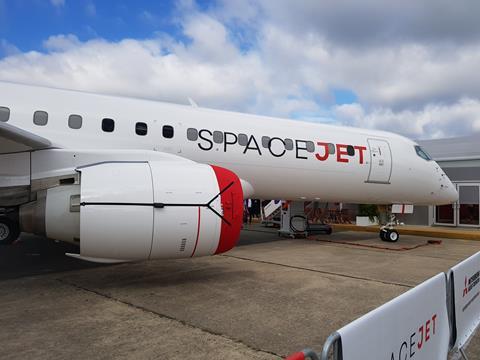The Japanese government’s long-term plans for a new commercial airliner in the 2030s stem from challenges facing its aerospace industry, notably a relative lack of exposure to the important narrowbody segment.
In presentations outlining the country’s new aerospace development strategy, announced in late March, the Japan Aircraft Development Corporation (JADC) underlines the critical importance of aerospace to Japan’s economy and strategic position, observing that several of the country’s leading companies have significant involvement in the sector.

JADC notes that Japanese tier one suppliers such as Mitsubishi Heavy Industries, Kawasaki Heavy Industries, and ShinMaywa are mainly involved with widebody programmes such as the Boeing 777 and 787.
They have much less exposure to the narrowbody segment, where JADC forecasts growth to be much stronger in the coming years as low-cost carriers – particularly those operating in the Asia-Pacific – use single-aisle aircraft for a greater variety of missions.
Moreover, as Japanese tier one suppliers are involved in several other industries in addition to aerospace, JADC suggests that this limits their ability to focus sufficient investment.
The presentations also touch on Japan’s failed attempt to develop a regional jet, the Mitsubishi Aircraft SpaceJet. JADC attributes the programme’s failure to a lack of understanding about the increasingly complex certification environment, as well as the flawed assumption that US pilot scope-clause rules would be relaxed, a key precondition to gain entry to the US market for the 90-seat M90.
A reliance on overseas suppliers for systems such as engines and avionics also created supply challenges as delays pushed out development times.
JADC indicates that Japan had also aimed to participate in Boeing’s conceptual NMA – New Midsize Airplane – but the programme was never launched.
As such, JADC calls for Japanese industry to break away from existing practice, where the country’s tier one suppliers effectively follow the lead of foreign OEMs such as Boeing.
Key areas of focus for the industry should be the development of advanced propulsion systems and establishing methods to design, test, and evaluate new aerospace technologies.
JADC also calls for extensive research into in hydrogen as an aviation fuel source, and the development of a test aircraft that can demonstrate cutting-edge technologies.
JADC says that it is essential for Japanese industry to attain greater participation in the OEM design process, including deep participation in the development of “the next-generation narrowbody” that will likely arrive in the mid-2030s. This work, it feels, will provide valuable learning opportunities and improve the overall capabilities of Japanese industry.
Ultimately, these efforts will provide the foundation for a “next-generation aircraft,” a major aircraft programme in which JADC foresees Japan rallying extensive international participation and moving domestic industry from tier one to OEM status.


























